Cote d Azur Travel Guide
Globally associated with glamour, celebrities, a vibrant nightlife and stunning beaches, the Cote d'Azur is a sun-drenched paradise that never ceases to captivate the imagination. Renowned as the playground of the rich and famous, it also boasts splendid shopping and restaurants, as well as some wonderful art galleries and museums.
The resort towns of Cannes and St Tropez are synonymous with the French high-life and never go out of fashion, while the charming city of Nice is full of pretty parks and gardens, along with opportunities for historical sightseeing. Marseille, just beyond the French Riviera, is a vibrant port city rapidly transforming into a centre for culture and entertainment. In between, the Cote d'Azur has some picturesque medieval villages to investigate and a pleasantly sleepy countryside that often goes unexplored by the throngs who visit its beaches and resorts.
Best time to visit Cote d'Azur
The French Riviera has a Mediterranean climate with hot summers and mild winters. Summer is the peak tourist season in the Cote d'Azur and the beaches can get extremely crowded at this time. Traffic congestion can also be a hindrance to getting around in the busy summer months and during the famous festivals, such as the Cannes Film Festival. Many prefer to avoid the busy summer months, though anyone travelling to the Cote d'Azur to enjoy the stunning beaches will find that summer is the best time to visit.
What to see in Cote d'Azur
-Go celebrity-spotting in glamorous Cannes.
-Visit the hillside village of Gassin for a taste of provincial Cote d'Azur.
-While away the time in a seafront cafe in St Tropez.
-Stroll along the shop-studded promenade of La Croisette.
What to do in Cote d'Azur
-Bask on one of the many famous beaches of the Cote d'Azur.
-Shop for traditional crafts in the medieval village of Biot.
-Take a boat trip to the islands of St Honorat and St Marguerite.
-Hike up to the botanical gardens in the dramatically situated village of Eze.
Getting there
Nice Côte d'Azur Airport is situated four miles (6km) west of the city. Buses leave regularly from the airport for hundreds of destinations all along Cote d'Azur. Flights to Nice Côte d'Azur Airport come from destinations all over Europe.
Did you know?
-The Cannes Film Festival was inaugurated in the 1930s in reaction to the interference of the fascist Italian and German governments in the selection of movies for the Venice film festival.
-About three quarters of the world's essences for perfumes are produced from the gardens of the French Riviera.
-In the peak summer months St Tropez welcomes up to 100,000 visitors a day.
Things to do in Cote d Azur
From the famous resorts along the French Riviera to the quaint medieval villages just inland, the attractions of Cote d'Azur never cease to enchant visitors. The beaches along this coastline are some of the most famous in the world, and Cannes and St Tropez in particular draw thousands of tourists every summer to bask on their golden shores. But there is lots to see and do in Cote d'Azur apart from swimming, suntanning, shopping and celebrity-watching at the fashionable resorts.
Cote d'Azur boasts some very special medieval villages. Biot, apart from being a pretty and well-preserved ancient town, is well known for its traditional crafts and is a lovely place to go shopping for souvenirs. Eze is perched dramatically on a steep hill and the views from this charming place are astounding. Grasse is famous for its perfume; visitors can learn about the production process and even create their own scents in this floral kingdom.
Along the azure coast, Antibes, St Raphael, Frejus, Cassis and, of course, Nice are all exciting places to visit. A boat trip to the islands of St Honorat and St Marguerite is a popular excursion from Cannes and an extremely pleasant way to spend a day. The islands are perfect for lazy picnics and walks and there is an 11th-century monastery, an old fortress and a fascinating Museum of the Sea to explore.
Travellers in Cote d'Azur will find that the coastline can get crowded and the roads congested during the summer months but, with a little patience and good planning, this area is magical.
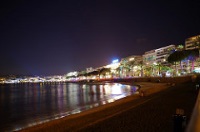
La Croisette
The long, shop-studded promenade of La Croisette, and its seven miles (11km) of beach, is Cannes' major attraction. Palatial hotels line this strip, each with their own private beach, and this is where visitors are most likely to spot a familiar face, or topless hopeful, especially during the Cannes Film Festival, though it can be difficult to see further than the sweating backs of the paparazzi during this popular event.
La Croisette is best viewed from the highest point of Cannes' Old Town, Le Suquet, where the remains of the fortified tower still stand, along with the 12th-century Chapel of St Anne. Le Suquet is a lovely place to stroll, with its winding streets, small boutiques and restaurants.
At the end of La Croisette is the Palais des Festivals, whose endless Allées des Stars is imprinted with handprints and signatures of the famous. Just beyond is the atmospheric Vieux Port, with its odd medley of luxury yachts and tiny fishing vessels, and the rows of palm trees and fragrant flower market of the Allées de la Liberté. Further west, along the seafront, are the free beaches (where the locals go), along the Plages du Midi.
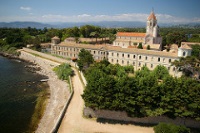
Ile St Honorat and Ile St Marguerite
The two islands of Lerins, Ile St Marguerite and Ile St Honorat, lie a 20-minute boat ride from Cannes. Ile St Honorat is a tiny forested island, the smallest and most southern of the Iles de Lerins. It has been the site of a monastery since the 5th century and today the Cistercian monks are the only inhabitants of the island.
Much of the monastery is surprisingly modern, with the exception of the ruins of the 11th-century monastery on the sea's edge. The monks organise tours of the island and sell their produce to tourists, including homemade wine, honey and lavender oil. The monastery also welcomes visitors for week-long retreats. On the neighbouring Ile St Marguerite is the fortress where the 'man in the iron mask' was imprisoned. The famous old prison also has a Museum of the Sea to explore.
Mostly, however, people head out to the islands to picnic and enjoy the natural splendour on offer. There are plenty of secluded, rocky little coves, forested areas and gardens and it is easy to find a beautiful spot to spend the day. It is the perfect opportunity to get out of the fashionable bustle of Cannes and find a little peace and privacy. The boat trips over are also enjoyable and give wonderful views of Cannes. There is a restaurant on Ile St Marguerite.
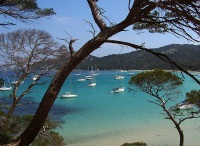
Côte d'Azur Beaches
The Cote d'Azur beaches range from intimate rocky coves to long swathes of golden sands packed with sun worshipers. Some are highly developed and will hire out loungers and the like but others are still fairly secluded; there should be something for everyone along this incredible coastline. Most beaches are away from the centre, although the family beaches, Plage des Graniers and Plage des Cannebiers, are within walking distance. Generally the beaches are very safe with calm seas, warm water and plenty of lifeguards on duty.
St Tropez and Cannes have some of the best coastlines in France. The string of beaches along the Baie de Pampelonne, south of St Tropez, the best known of which is the Plage de Tahiti, have long been favoured by exhibitionists wearing next to nothing. Villefranche sur Mer is a beautiful, sandy beach great for snorkelling. The beaches of Ile de Porquerolles, in the national park, are coveted by nature lovers. Other favourites include Plage Port Grimaud, Monte-Carlo Beach and Vias Plage. Almost all the beaches are lined with restaurants and shops selling endless gifts or items to prove visitors have been there. A huge variety of watersports are on offer.
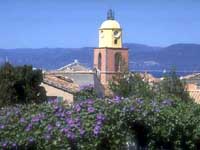
St Tropez
St Tropez has long held the reputation of being the 'black sheep' of the renowned French Riviera holiday resort towns. Sexy starlets were flaunting themselves topless here back in the 1930s, long before the beautiful people dared disrobe elsewhere. St Tropez' reputation as a kinky carnival town attracting the more bohemian members of the 'in' crowd continues to this day.
There is little left of the medieval Provencal atmosphere of the original town. From May to September, St Tropez is the wild holiday destination people imagine, but in the off season the town virtually shuts down, reverting to a quieter, calmer existence. Behind the rows of yachts fronting the terraced cafés of the waterfront are some narrow, picturesque streets full of shops. The hub of the town is the Place aux Herbes, a busy enclave of fish, fruit, vegetable and flower stalls.
The beach in St Tropez is famous, and has a number of bars, cafes, and watersports options, especially the popular Plage de Tahiti. The beaches west of St Tropez are popular with nudists. Visitors can stroll the Sentier Littoral, a coastal walking route with fabulous views, or visit the Musée de I'Annonciade, which has an exceptional collection of post-Impressionist paintings.
The area around Quai Jean Jaures on the waterfront is where the best of the nightlife can be found. Within town there are charismatic and laid-back bars in and around Place des Lices. For celebrity spotting and pricey champagne cocktails, visitors should get dressed up and head to Nikki Beach.
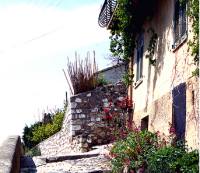
Biot
The village of Biot is more than 2,500 years old, and retains much of its medieval charm in the 15th-century architecture and narrow, winding streets. The town's old walls and gate can still be seen, as well as a number of other small, historic features strewn throughout the hilltop community. The town has been a hub for craftsmen for centuries, and is known for its pottery and blown glass, making it a popular shopping destination for tourists in the French Riviera. There are several glass-blowing factories that offer tours, allowing visitors to watch the age-old process in action.
Biot is also the site of an ancient volcano, and geology buffs will enjoy hiking the scenic rock formations. There are several other pleasant walks through the surrounding hills and woods and the feel in the countryside is pastoral and peaceful, with plenty of shade and bubbling streams.
Located less than three miles (4km) from the coast, Biot makes an excellent daytrip when visitors want a break from the pleasures of the beach. The village is busy year-round but gets particularly crowded during the summer (June to August); even so, it is slightly off the main tourist path and remains one of the less commercial villages.
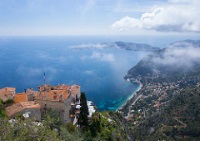
Èze
Perched on a mountain 1,400 feet (427m) above sea level, the medieval town of Èze is a popular stop on the route between the French Riviera and Monaco. The winding cobblestone streets lead visitors to the ruins of a 12th-century castle, and also to many shops; shopping is one of the most popular reasons for visiting Èze. The streets are dotted with tiny boutiques and shops selling a variety of French souvenirs.
There are stunning views of the Mediterranean from this charming hilltop village but, because it is so steep and medieval, with its little houses crammed together on winding, cobbled streets, the views from inside are often limited. To fully appreciate the location of the place, visitors must climb into the botanical gardens, Le Jardin d'Eze, which perch on top of the hill. There are magnificent 360 degree views from the top and some interesting ruins too. It is quite a climb though, so visitors should dress accordingly. Another popular attraction in the village is the Fragonard - L'Usine Laboratoire, a factory where they make beautiful perfumes and fragrances, where visitors can be guided through the process as well as buy some lovely scents at reduced prices.
Eze feels like a place stuck in a quaint and artistic past and it is a delight to explore; it is less fashionable and celebrity-packed than many places in Cote d'Azure and this is part of its appeal.
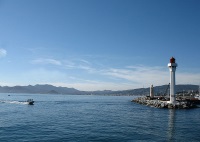
Cannes
Today it is hard to imagine that the quintessential, glamorous French Riviera holiday resort of Cannes was for centuries a simple, sleepy fishing village whose only visitors were the monks and wealthy pilgrims who came to visit the monastery on the nearby Island of St Honorat. All this changed in 1834 when Lord Henry Brougham, former British Chancellor of the Exchequer, arrived and established Cannes as a popular upmarket holiday resort for the British upper-classes.
Soon the French and later the Russian aristocracy also flocked to Cannes to while away their summer holidays. Today, Cannes is besieged by tourists on holiday in the summer, when the long sandy beaches, glitzy nightclubs, chic shops and famous promenade are abuzz with beautiful people flaunting the latest designer wear.
There is lots to see and do in Cannes. The old town is pleasant for strolling and sightseeing, and the beaches fantastic for lying in the sun. For the more active, there are a number of water sports available, including sailing and swimming. Popular attractions in Cannes include the Notre-Dame d'Esperance, the Molinard perfume factory, and the Musée d'Art et d'Histoire de Provence. It is worthwhile to take the trip out to the Îles de Lérins, which boast a monastery and ruins alongside a number of shops, bars and restaurants. There are also options for excursions to nearby Monaco and St Tropez.
Each May the world's media descend in droves for the annual Cannes Film Festival, which draws Hollywood's finest to the Palais des Festivals.
Cote d Azur Climate and Weather
A Mediterranean climate prevails along the coast of the French Riviera, with long hot summers and mild winters. The region enjoys a pleasant, warm climate throughout the year. During the hottest summer months, particularly in August, temperatures often reach excesses of 86F (30C), while maximum temperatures in winter are usually between 50 and 59F (10 to 15C). August is the hottest month and January is the coldest. Rainfall is moderate and mostly occurs during winter; October is usually the wettest month. Snowfall is extremely rare. Strong winds, known as la Mistral, can occur, particularly during winter and spring (November to April).
Summer is peak tourist season in Cote d'Azur and this is the best time of year to visit for those planning to enjoy the beaches. However, the spring months of April and May can be lovely and the coast is far less crowded. Visitors will get plenty of sun but the water will be too cold for swimming, making spring the ideal time to go for those who want a scenic, sightseeing holiday. Autumn can be rainy but the weather is mild and this can also be a pleasant time to visit.
France travel info
Electricity
The electrical current is 230 volts, 50Hz. European two-pin plugs are standard.
Language
French is the official language.
Money
The euro (EUR) is the official currency in France. Currency can be exchanged at banks, bureaux de change and some large hotels, though visitors will get a better exchange rate at the ATMs. Major credit cards are widely accepted, particularly in major tourist destinations. Foreign currency is not accepted.
Tipping
Most restaurants and hotels automatically add a 15 percent service charge so a tip is not necessary, although another two to three percent is customary if the service has been good. If service is not included then 15 percent is customary. Taxi drivers expect 10 to 15 percent of the fare, and hairdressers about 10 percent. Hotel staff generally receive about €1.50 a day and tips of about €1 are given to washroom and cloakroom attendants and museum tour guides. Tour bus drivers and guides are also tipped.
Health
No particular vaccinations or medications are required for travel to France. The prevalence of certain tick-borne infections, such as lyme disease, tularemia, tick-borne encephalitis, and rickettsial diseases, mean that travellers should take precautions against ticks if they are travelling in rural or forested areas in warm weather. French hospitals and health facilities are first class. Visitors from other EU countries are entitled to discounted medical treatment and medicines on presentation of a European Health Insurance Card (EHIC). After Brexit, the Global Health Insurance Card (GHIC) replaced the European Health Insurance Card (EHIC) for UK citizens. The GHIC allows UK citizens access to state healthcare during visits to the EU. The GHIC is not valid in Norway, Iceland, Liechtenstein or Switzerland, nor is it an alternative to travel insurance. Otherwise, doctors and hospitals often expect immediate cash payment for health services, so medical insurance is advised.
Safety
While violent crime against tourists is rare and holidays in France are generally trouble-free, visitors should be mindful that security has been heightened following a series of terrorist attacks in recent years, particularly in the transport sector. Unattended luggage left in public places will be removed or destroyed by security staff. While generally safe, visitors to France are advised to take precautions against petty theft and to ensure their personal safety. Thieves and pickpockets operate on the metro and around airports. Theft from cars is prevalent, particularly in the south, around Marseilles, and in Corsica. Tourists are advised to conceal bags and purses even when driving, and to never leave valuables unattended in the car. Bag snatching is also common, particularly on public transport and in shopping centres, and visitors should also be vigilant of luggage while loading bags into and out of hire cars at airports.
Local customs
French culture is of paramount importance to the French people. In an increasingly Americanised world they feel duty-bound to protect it, and it is appreciated if visitors can speak a few words of French. Locals do not respond well to being shouted at in English. While the food is second to none, foreigners may find the service in many restaurants sloppy. Waiters can appear rude (particularly in Paris) and take their time. This is just the way they are. Traditional games such as pétanque (similar to lawn bowling but played on gravel) are popular in village squares, but the national sports are football, rugby and cycling. Smoking in public places is not allowed and will incur heavy fines.
Doing business
Business etiquette is important in France. A smart, fashionable sense of dress is common as the nation prides itself on haut couture. Punctuality is not always observed though and the 'fashionably late' tactic may be applied. A handshake is the common form of greeting for men and women upon first introductions. Titles are important and the person is to be referred to as 'monsieur' (Mr.), 'madame' (Mrs.), or 'mademoiselle' (Ms.). Meetings usually occur over lunches, and the French are known to enjoy food. Business hours are generally 9am to 6pm, Monday to Friday.
Duty free
Travellers from non-EU countries over 17 years of age entering France can bring in the following items duty-free: 200 cigarettes, or 100 cigarillos, or 50 cigars, or 250g tobacco. Four litres of wine and 16 litres of beer and one litre of spirits over 22 percent or two litres of alcoholic beverages less than 22 percent. Other goods up to the value of €430 for air and sea travellers, and €300 for other travellers (reduced to €175 for children under 15 years of age).
Communications
The international access code for France is +33. Travellers can purchase local prepaid SIM cards for unlocked phones or use eSIMs if their cellular providers support it on their networks. Free WiFi is available in most hotels, cafes, restaurants and similar establishments.
Passport & Visa
The borderless region known as the Schengen Area includes the following countries: Austria, Belgium, Czech Republic, Denmark, Estonia, Finland, France, Germany, Greece, Hungary, Iceland, Italy, Latvia, Lithuania, Luxembourg, Malta, The Netherlands, Norway, Poland, Portugal, Slovakia, Slovenia, Spain, Sweden, and Switzerland. All these countries issue a standard Schengen visa that has a multiple entry option, and which allows the holder to travel freely within the borders of all the aforementioned countries.
Additionally, travellers must hold sufficient funds to cover their stay in France, and proof of repatriation (a return or onward ticket, and the necessary travel documentation for their next destination). Note that Schengen visas, if required, are also valid for French Guiana and French West Indies and Reunion, provided that the Schengen visa is endorsed "Also valid for French territories being in observation of the respective French territories". We recommend that passports always be valid for six months after intended period of travel.
Entry requirements
US citizens must have a passport that is valid for at least three months after their intended departure from France (and issued within the last 10 years). No visa is required for a stay of up to 90 days within a 180-day period.
UK citizens must have a passport that is valid for at least three months after their intended departure from France (and issued within the last 10 years). No visa is required for a stay of up to 90 days within a 180-day period.
Canadian citizens must have a passport that is valid for at least three months after their intended departure from France (and issued within the last 10 years). No visa is required for a stay of up to 90 days within a 180-day period.
Australian citizens must have a passport that is valid for at least three months after their intended departure from France (and issued within the last 10 years). No visa is required for a stay of up to 90 days within a 180-day period.
South African citizens must have a passport that is valid for at least three months after their intended departure from France and must obtain a valid Schengen visa prior to travel. Passports must have at least two blank pages. Entry and transit may be refused to holders of temporary passports.
Irish citizens must have a passport that is valid on arrival. No visa is required.
New Zealand citizens must have a passport that is valid for at least three months after their intended departure from France (and issued within the last 10 years). No visa is required for a stay of up to 90 days within a 180-day period.
Useful contacts
Maison de la France (Tourist Information Agency), Paris: www.france.fr/fr
112 (General emergency)


